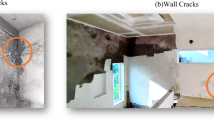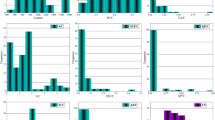Abstract
This paper investigates the impacts of fuzzy genetic (FG), a new fuzzy logic model with genetic algorithm, artificial neural networks (ANN) and general linear model (GLM) approaches on abrasive wear of concrete. For this purpose, experimental studies were made to investigate the influence on wear of the following input parameters: hematite, cement, compressive strength and different loads on the experiments. In these models, 60 data sets were used. For training set, 48 data (80 %) were randomly selected and the residual data (12 data, 20 %) were test set. Model results were compared with experimental results. In this paper, main model performance criterion was root mean square errors. Also, sum of squared error and determination coefficient statistics were used as comparing criteria for the evaluation of models’ performances. Comparison results indicate that FG models are superior to ANN and GLM models in modeling of influence hematite, cement, compressive strength and loads on wear of concrete.











Similar content being viewed by others
References
Hui L, Zhang MH, Ou JP (2006) Abrasion resistance of concrete containing nano-particles for pavement. Wear 260:1262–1266
Sebok T, Stranel O (2004) Wear resistance of polymer-impregnated mortars and concrete. Cem Concr Res 34:1853–1858
Brostow W, Hagg HE (2008) Predicting wear from mechanical properties of thermoplastic polymers. Polym Eng Sci 48:1982–1985
Gyurova LA, Justel PM, Schlarb AK (2010) Modeling the sliding wear and friction properties of polyphenylene sulfide composites using artificial neural networks. Wear 268:708–714
Naik TR, Singh SS, Hossain MM (1994) Abrasion resistance of concrete as influenced by inclusion of fly ash. Cem Concr Res 24(2):303–312
Atis CD (2002) High volume fly ash abrasion resistant concrete. J Mater Civil Eng 14(3):274–277
Zhang Z, Friedrich K (2003) Artificial neural networks applied to polymer composites: a review. Compos Sci Technol 63:2029–2044
Jiang Z, Zhang Z, Friedrich K (2007) Prediction on wear properties of polymer composites with artificial neural networks. Compos Sci Technol 67:168–176
Zhang Z, Friedrich K, Velten K (2002) Prediction on tribological properties of short fibre composites using artificial neural networks. Wear 252:668–675
Demir F (2005) A new way of prediction elastic modulus of normal and high strength concrete-fuzzy logic. Cem Concr Res 35(8):1531–1538
Unal O, Demir F, Uygunoglu T (2007) Fuzzy logic approach to predict stress-strain curves of steel fiber-reinforced concretes in compressive. Build Environ 42(10):3589–3595
Tanyildizi H (2009) Fuzzy logic model for the prediction of bond strength of high-strength lightweight concrete. Adv Eng Softw 40(3):161–169
Catallo L (2003) Reliability structural assessment of concrete structures using genetic algorithms and nonlinear analysis. Comput Fluid Solid Mech 2003:2237–2240
Chul-Hyun L, Young-Soo Y, Joong-Hoon K (2004) Genetic algorithm in mix proportioning of high-performance concrete. Cem Concr Res 34(3):409–420
Fairbairn EMR, Silvoso MM, Filho RDT, Alves JLD, Ebecken NFF (2004) Optimization of mass concrete construction using genetic algorithms. Comput Struct 82(2–3):281–299
Konstantin S, Amirjanov A (2010) Application of genetic algorithm for modeling of dense packing of concrete aggregates. Constr Build Mater 24(8):1449–1455
Naso D, Surico M, Turchiano B, Kaymak U (2007) Genetic algorithms for supply-chain scheduling: a case study in the distribution of ready-mixed concrete. Eur J Oper Res 177(3):2069–2099
Coello CC, Hernandez FS, Farrera FA (1997) Optimal design of reinforced concrete beam using genetic algorithms. Expert Syst Appl 12(1):101–108
PrendesGero MB, Bello García A, del Coz Díaz JJ (2005) A modified elitist genetic algorithm applied to the design optimization of complex steel structures. J Constr Steel Res 61(2):265–280
PrendesGero MB, Bello García A, del Coz Díaz JJ (2006) Design optimization of 3D steel structures: genetic algorithms vs. classical techniques. J Constr Steel Res 62(12):1303–1309
Altun F, Kisi O, Aydin K (2008) Predicting the compressive strength of steel fiber added lightweight concrete using neural network. Comput Mater Sci 42:259–265
Yeh IC (1999) Design of high-performance concrete mixture using neural networks and nonlinear programming. J Comput Civil Eng 13:36–42
Oh JW (1999) Application of neural networks for proportioning of concrete mixes. ACI Mater J 96:61–67
Ji T (2006) A mortar mix proportion design algorithm based on artificial neural networks. Comput Concr 3:357–373
Ji T, Lin T, Lin X (2006) A concrete mix proportion design algorithm based on artificial neural networks. Cem Concr Res 36:1399–1408
Oztas A, Pala M, Ozbay E, Kanca E, Caglar N, Bhatti MA (2006) Predicting the compressive strength and slump of high strength concrete using neural network. Constr Build Mater 20(9):769–775
Yeh IC (2007) Modeling slump flow of concrete using second-order regressions and artificial neural networks. Cem Concr Compos 29:474–480
Yeh IC (2008) Modeling slump of concrete with fly ash and superplasticizer. Comput Concr 5(6):559–572
Yeh IC (2008) Prediction of workability of concrete using design of experiments for mixtures. Comput Concr 5(1):1–20
Demir F (2008) Prediction of elastic modulus of normal and high strength concrete by artificial neural networks. Constr Build Mater 22:1428–1435
Bilgehan M, Turgut P (2010) Artificial neural network approach to predict compressive strength of concrete through ultrasonic pulse velocity. Res Nondestr Eval 21:1–17
Bilgehan M, Turgut P (2010) The use of neural networks in concrete compressive strength estimation. Comput Concr 7(3):271–283
Lee SC (2003) Prediction of concrete strength using artificial neural networks. Eng Struct 25:849–857
Mukherjee A, Biswas SN (1997) Artificial neural networks in prediction of mechanical behavior of concrete at high temperature. Nucl Eng Des 178:1–11
Kaplan MF (1989) Concrete radiation shielding. Wiley, New York
ASTM C127 (2007) Standard test method for density, relative density (specific gravity), and absorption of coarse aggregate, ASTM annual book of ASTM standards
ASTM C128 (2007) Standard test method for density, relative density (specific gravity), and absorption of fine aggregate, ASTM annual book of ASTM standards
ASTM C29 (2007) Standard test method for bulk density (unit weight) and voids in aggregate, annual book of ASTM standards
ASTM C511 (2006) Standard specification for mixing rooms, moist cabinets, moist rooms, and water storage tanks used in the testing of hydraulic cements and concretes, annual book of ASTM standards
ASTM C39 (2009) Standard test method for compressive strength of cylindrical concrete specimens, annual book of ASTM standards
TS 699 (2009) Natural building stones—methods of inspection and laboratory testing. Turkish Standards Institution, Ankara, in Turkish
ASTM C779 (2000) Standard test method for abrasion resistance of horizontal concrete surfaces, annual book of ASTM standards
Yazıcı S, Inan G (2006) An investigation on the wear resistance of high strength concretes. Wear 260:615–618
Arslan M (2001) The effects of permeable formworks with sucker liners on the physical properties of concrete surfaces. Constr Build Mater 15:149–156
Zadeh LA (1965) Fuzzy sets. Inf Control 8(3):338–353
Kosko B (1993) Fuzzy thinking: the new science of fuzzy logic. Hyperion, New York
Ross TJ (1995) Fuzzy logic with engineering applications. McGraw-Hill, New York
Russell SO, Campbell PF (1996) Reservoir operating rules with fuzzy programming. J Water Resour Plann Manage 122(3):165–170
Sen Z (1998) Fuzzy algorithm for estimation of solar irradiation from sunshine duration”. Sol Energy 63(1):39–49
Kiszka JB, Kochanskia ME, Sliwinska DS (1985) The influence of some fuzzy implication operators on the accuracy of fuzzy model. Part I Fuzzy Sets Syst 15:111–128
Kiszka JB, Kochanskia ME, Sliwinska DS (1985) The influence of some fuzzy implication operators on the accuracy of fuzzy model. Part II Fuzzy Sets Syst 15:223–240
Kisi O (2010) Fuzzy genetic approach for modeling reference evapotranspiration. J Irrig Drain E-ASCE 136(3):175–183
Burn DH, Yulianti JS (2001) Waste-load allocation using genetic algorithms. J Water Resour Plann Manage 127(2):121–129
Ahmed JA, Sarma AK (2005) Genetic algorithm for optimal operating policy of a multipurpose reservoir”. Water Resour Manage 19:145–161
Wang QJ (1991) The genetic algorithm and its application to calibrating conceptual rainfall-runoff models. WaterResour Res 27(9):2467–2471
Goldberg DE, Deb K (1990) A comparative analysis of selection schemes used in genetic algorithms, foundation of genetic algorithms. Morgan Kaufman, San Mateo, pp 69–93
Oliveira R, Loucks DP (1997) Operating rules for multireservoir systems. Water Resour Res 33(4):839–852
Goldberg DE (1989) Genetic algorithms in search: optimization and machine learning. Addison-Wesley, Reading
Haykin S (1998) Neural networks: a comprehensive foundation, 2nd edn. Prentice-Hall, Upper Saddle River
Cigizoglu HK, Kisi O (2005) Flow prediction by three back propagation techniques using k-fold partitioning of neural network training data. Nord Hydrol 36(1):49–64
Hagan MT, Menhaj M (1994) Training feedforward networks with the Marquardt algorithm. IEEE Trans Neural Netw 5(6):989–993
Kocabas F, Kisi O, Ardıclioglu M (2009) An artificial neural network model for prediction of critical submergence for an intake in a stratified fluid media. Civ Eng Environ Syst 26(4):367–375
More JJ (1997) Lecture notes in mathematics. The Levenberg-Marquardt algorithm: implementation and theory. In: Watson GA (ed) Numerical analysis. Springer, pp 630:105–116
Kocabas F, Unal S, Unal B (2008) A neural network approach for prediction of critical submergence of an intake in still water and open channel flow for permeable and impermeable bottom. Comput Fluids 37:1040–1046
Gencel O (2009) The application of artificial neural networks technique to estimate mass attenuation coefficient of shielding barrier. Int J Phys Sci 4(12):743–751
SPSS Inc, SPSS Base 12.0 user’s guide, Chicago, IL USA, 2003
Tasdemir Y, Agar E (2007) Investigation of the low temperature performances of polymer and fiber modified asphalt mixtures. Indian J Eng Mater Sci 14:151–157
Kocabas F, Unal S (2010) Compared techniques for the critical submergence of an intake in water flow. Adv Eng Softw 41(5):802–809
Keskin ME, Terzi O, Taylan D (2004) Fuzzy logic model approaches to daily pan evaporation estimation in western Turkey. Hydrol Sci J 49(6):1001–1010
MATLAB (ver 7.0). The MathWorks Inc., 3 Apple Hill Drive, Natick (MA)
Dawson WC, Wilby R (1998) An artificial neural network approach to rainfall-runoff modelling. Hydrol Sci J 43(1):47–66
Author information
Authors and Affiliations
Corresponding author
Rights and permissions
About this article
Cite this article
Gencel, O., Kocabas, F. & Coz Diaz, J.J.d. A comparative modeling study to estimate wear of concrete. Neural Comput & Applic 24, 649–662 (2014). https://doi.org/10.1007/s00521-012-1277-7
Received:
Accepted:
Published:
Issue Date:
DOI: https://doi.org/10.1007/s00521-012-1277-7




